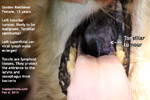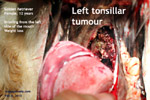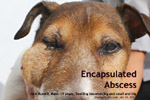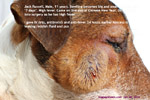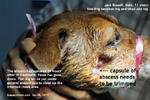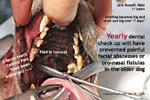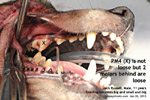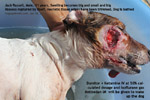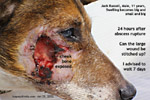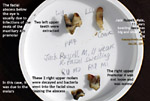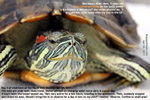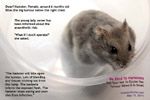Case 1.
A 12-year-old well cared for female, Golden Retriever, drooling on the left side only.
Vet 1 did dental scaling and extraction. Dog then started "drooling on left side."
Vet 1 then smoothened left lower PM4 since the upper PM4 and others had been extracted. Still the drooling persisted. Vet 2 was "thorough" according to the owner. He X-rayed and ultrasound the whole body. "How about the head and neck area?" I asked. The owner did not think this was done.
According to the owner, said a big lump was present on the left back of mouth and a spherical lump on left neck below the submandibular. He recommended steroids as an alternative to euthanasia and surgery. When the dog was on steroids, she was very hungry and drank a lot. When given Tramadol, the drooling stopped. The dog had lost a lot of weight.
The dog did not want the mouth to be opened but I managed to open it and showed the owner and her sister the large tonsillar tumour (at least 3 cm x 2 cm). Pain and ulcerations there would be the cause of drooling.
CASE 2
Surprising an 8-year-old small breed came in for
review after this Golden Retriever. I had done dental
scaling 4 weeks ago. The dog objected strongly to the
mouth being opened, but I could see the right tonsil
as reddish lump 0.5 x 0.5 cm. I had told the owner of
this lump seen during dental scaling. It could be a
tonsillar tumour. The owner would wait and see.
If dog owners regularly check the dog's teeth and keep
it cleaned or scaled yearly or two-yearly, many
oral tumours would not form. This is the same with
human beings too. A poor hygiene in the mouth
predisposes to oral tumours and this is commonly
reported. Tonsillar tumours are not so common.
However, during dental check up, the vet must note and
record the condition of the tonsils and let the owners
be informed if they are abnormally enlarged.
CASE 3
"See the lump under the right eye," I had pointed it
out to her at the waiting area. Later, she gave me
permission to take a photo. "That is the beginning of
a malar abscess - infection from the root of the back
tooth into the sinus and bulging out." She had come
for advice as Vet 1 wanted her to sign an indemnity
form for dental work in case the dog dies under
anaesthesia.
"How many deaths were under you while you did dental
scaling?" the young lady was very worried about her
8-year-old Chihuahua who had Stage 4 periodontal
disease (the worst stage) and asked Dr Vanessa who was
handling the case together with me. She did most of
the talking. Many times, I would see the case together
with her and most of the time, she would be doing the
talking. Some owners would think I am an assistant and
know nothing and so why was I giving medical advices?
I usually identify myself as a vet first.
"How many?" the young lady asked again. "Ask Dr Sing,"
Dr Vanessa replied.
"In my over 30 years of dental scaling and I can only
speak for myself, I don't have any cases of dogs doing
dental work dying on the operating table," I replied.
"Dental work or scaling takes a short time of less
than 15 minutes unlike long surgeries and therefore,
anaesthetic deaths are uncommon in many senior dogs. A
very close focus on anaesthesia by the vet and his
assistant is very important. In old dogs, I don't give
IV sedation but just isoflurane gas only."
The young lady was already red-eyed but well read
about anaesthetic deaths of dogs on the operating
table. I could understand her concern for the
Chihuahua which was in good bodily condition unlike
those skinny ones. A bit plump is better as this
indicated that this dog was well cared for and had a
good appetite (meaning good health too.)
"A blood test is taken to screen the dog's health
first," Dr Vanessa said as she examined the heart and
lungs and found them OK.
"A 10-day course of antibiotics before dental scaling
is what I recommend usually to clients," I said. "The
dental scaling is done around 7-10 days later and the
mouth would be free of bacteria."
The boyfriend asked the young lady (in her late 20s)
to wait for the blood test. So, it was quite an
emotional consultation.
This Sunday was an eventful one as my assistant Min
fell sick with flu. He left at 10 am to see the doctor
and had the day off. Ms Ong, a junior college student
with an offer from Glasgow Univ for vet studies came
for her first day and so she got to see all the cases
since the other three interns (Kim quitted suddenly as
she found that it was too costly to study vet
medicine, Mr Lim was said to have dengue fever, Grace,
going to 2nd year vet student from Sydney Univ would
come only on Monday.
It was a bright sunshine Sunday and we managed to
close at 5.30 pm. I advised Dr Vanessa to record as
she communicate to the client as this is what I do,
but she had her own style of writing only after
everything. So there was much delay. Record what the
client said e.g. history on the spot. That would be
the efficient way as many clients dislike waiting too
long. Some of the clients had to wait more than an
hour and from my view at the reception, many prefer
short consultations and getting the problem resolved.
Waiting more than 15 minutes at the doctor is not a
happy event for any Singaporean on a Sunday when there
are so many things to do!
 TOA
PAYOH VETS
TOA
PAYOH VETS
